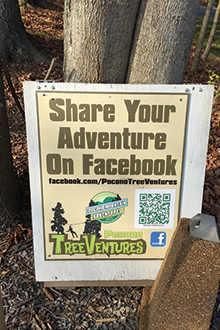Continued from page 2
Making the Effort
So then, if the benefits are clear, why have more parks not yet opted in?
“It isn’t the cost, which everyone thinks it is,” Kottke says. “I find it is a more of an, ‘I’m busy with all this other stuff, I don’t have time for this now.’ But I see it this way: There are people who work on their business, and then there are people who work in their business. Those who work ‘in’ find the time to add beneficial things like this.”

Photo-viewing kiosks at TreeVentures in Pennsylvania.
He also says that since most parks don’t have digital marketing managers, they may not know how easy it is to post and tag photos on sites like Instagram and get your name out there. If the park management doesn’t have the know-how, many of the staff may. It’s quick to learn and do in either case.
And even if you don’t consider the vast marketing potential of souvenir photography, he says, there is money to be made in the souvenirs themselves. “There is a significant amount of photo revenue to be had at any park, and it is as simple as that. If a park is not taking advantage, it doesn’t understand its market.”

A promotional photo-sharing sign at TreeVentures increases guest sharing and word-of-mouth marketing for the park.
O’Grady believes that soon, more and more parks will take the plunge. “Photo service is more than a money tool or revenue generator,” he says. “The marketing numbers we see are incredible.”
Even so, souvenir photos are too valuable to simply give away. “People don’t value what is free,” he says. “Even if you make it a low price point, that’s better than free. You want to make it an easy decision, but put a price on it. Then everyone is happy.”
O’Grady believes understanding this—the huge market of giving customers that immediate chance to join in a modern day, social media “show and tell”—is coming to parks. More and more will join in.
With that, he feels, the entire industry will be lifted. “The more people see what we are doing, the more they are going to want to be part of it. This is good for everyone.”
GAUGING THE REVENUE POTENTIAL
According to Ben Kottke of Snapsportz, the main factors that determine how much revenue/profits an owner can expect are:
- number of challenge course customers per year/season;
- number of cameras, automated and handheld, on each course—more cameras = more photos = more revenue;
- camera placement, which affects photo quality;
- uniqueness of the course;
- total cost to the customer;
- market demographics, which impact prices parks can charge;
- cost of the system—variables include number of cameras, power availability, and wireless networking.
Examples:
1. A zip line in Hawaii has a very unique course, with 90 percent Pacific Ocean views. Clients are mostly upscale tourists. Course costs $180 per person. It charges $40 for all of one customer’s digital images ($60 for a couple, $80 for a family). Photos are taken by four automated cameras and two handheld cameras. The park has approximately 30,000 customers per year, and forecasts that souvenir photography will generate close to $300,000 gross in its first year. Given development, installation, and ongoing costs, it expects $200,000 profit for year one, and $270,000 in subsequent years, assuming steady visitation.
2. A ropes course in North Carolina, also unique, but drawing from tourists of a different demographic. It charges $50 per person. Photos come from two handheld cameras; the course charges $15 per person for all of a customer’s digital images. The course anticipates 15,000 customers per season, and expects photo sales to generate $100,000 in gross revenue per year. After costs, it projects $70,000 in profit in year one, and $90,000 in following years.
To help operators predict their own costs and potential revenue stream, Snapsportz offers a revenue calculator at www.snapsportz.com/revenue.html.






